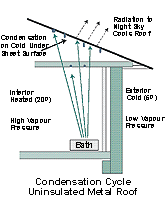Tools & Resources
Prevent Condensation Problems
Condensation forms under/on roof sheeting when the sheeting becomes colder than the air in contact with it. Water vapour carried in the air then condenses on the colder surface of the roof sheet. To minimise the risk of water damage to ceilings or corrosion related to condensation under steel roof sheeting, a vapour barrier should be provided under the sheeting to prevent contact between the moist air in the building and the roof sheeting.
Reflective foil laminates (sarking) which are commonly used to provide heat insulation under roof sheeting can serve a dual function as a vapour barrier, by thoroughly sealing the foil overlaps with moisture impervious adhesive tape.
The laps should be about 100 mm and kept in close contact when positioning the laminate so the tape can be readily applied.
The laminate must be allowed to drape between the roof supports so that the cold temperature of the roof sheeting will not be transmitted to the laminate by contact. If this were to happen condensation could form on the underside of the laminate and may drip into the ceiling space.
Ventilation of the ceiling cavity may assist in the reduction of condensation however it has been shown that ventilation will not completely eliminate the condensation cycle. In certain marine situations ventilation may also carry salts into the roof cavity which will, in the presence of condensation, lead to accelerated corrosion attack.
For more information, please see "Corrosion Technical Bulletin 11 - Condensation"


